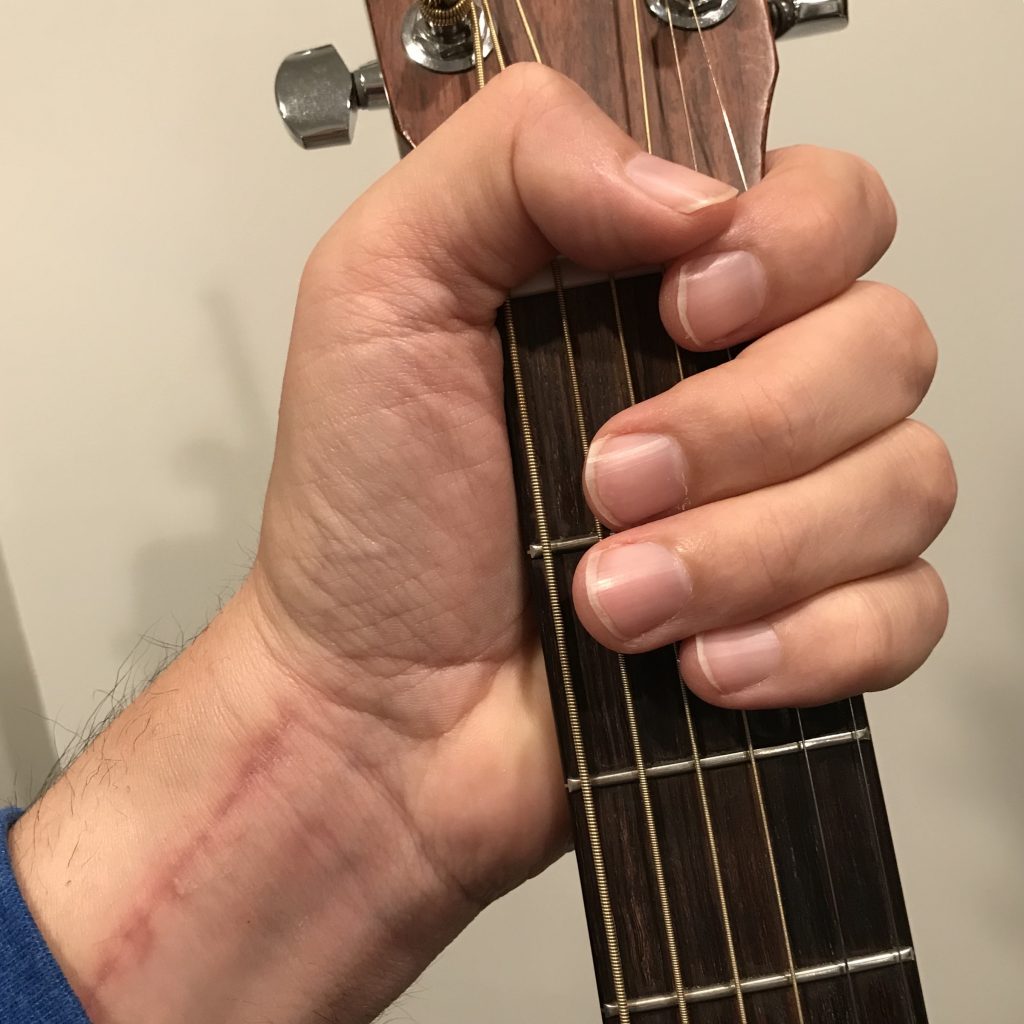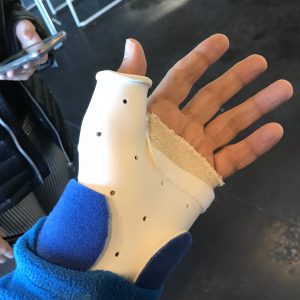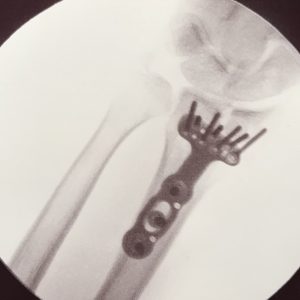A few thoughts about my return to playing after distal radius and ulnar styloid fracture and Colles’ Fracture surgery.

A few years ago, I experienced a broken wrist in a high-speed cycling crash. I had surgery on the wrist and went through occupational therapy, and eventually returned to playing the guitar. I hadn’t thought to share my experience with other guitarists because I assumed that every break is unique, but this winter my wife had a Colles’ fracture of her wrist in a fall while hiking. Her ER x-ray looked very similar to mine and her post-surgical x-ray was also almost identical, which made me think that maybe my experience wasn’t so unusual after all. So, in hopes that this helps someone else who is rehabbing from a Colles’ fracture and hopes to start or continue playing guitar, I’ll tell you a bit about my experience. I should mention that I broke my left wrist — the wrist on the fretting side, not the strumming side.
I also want to point out that I’m not a doctor, physical therapist, or any sort of medical expert. I’m just a guy who broke his wrist.
What is a Colles’ fracture?
A Colles fracture is a fracture of the distal radius, which is fancy medical talk for “breaking off the end of the big bone in your forearm”. There are two bones in your forearm, and the radius is the one closer to your thumb. A Colles fracture is so-named because this sort of fracture is so common (it is a common result of falling down on an outstretched hand) that a surgeon named Abraham Colles wrote a study of them in the mid- 19th century.
Returning to guitar after wrist surgery

Initially, I wasn’t able to play guitar at all after surgery. The primary reason for not being able to return to play was that the splint on my arm, which went up basically to the base of my fingers and circled my thumb, prevented me from even holding the neck of the guitar. So, for the first two weeks or so, it wasn’t even worth trying.
Playing didn’t really become possible until about three weeks post-op, when I was switched to a removable splint. At that point I began doing exercises for range of motion (known in the biz as “ROM”). The one that my doctor and physical therapist put the most emphasis on was supination (rotating my hand so that the palm is up), and there’s no question that’s a very important skill (if you don’t get all of your ROM back for pronation –palm down like in typing– it’s possible to compensate by lifting your elbow, but there’s no real way to cheat if you can’t supinate). The one that I think was most important for guitar is adduction (bending your wrist to move your pinky toward your forearm) which happens to be the another motion you need to type on a keyboard).
When I went to occupational therapy, my therapist had me name three things that I wanted to be able to do, and she targeted those activities for exercise. Unfortunately, she wasn’t a guitarist and didn’t have much in the way of guitar-specific exercises. My recovery was going well and I felt pretty confident, so I didn’t really worry about it, but if I had it to do over again, I think I would have maximized the rehab opportunity by bringing my guitar and demonstrating what I needed to do. I’m not sure exactly what guitar-specific PT exercises would be, but that’s your therapist’s job to figure out.
Fretting a guitar and physical therapy
There are two things about fretting a guitar that make it somewhat unusual from a PT perspective.
The first is the need to adduct, which I mentioned before. I worked on the regular adduction exercises, and on the guitar I used a capo to play high on the neck (seventh fret or so). The further your hand is from your body the more adduction is needed, so it’s easiest to play up the neck to start and move down as your adduction gets better.

The other thing that is almost unique about playing the guitar is the need to be able to press down with your fingers/fingertips without actually closing your fist. There weren’t any exercises in my PT regimen that demanded that particular skill. I found that trying to fret the guitar, even when my wrist permitted me to get into position, was fairly painful, and took a while to come back. Perhaps this had to do with inflammation in my wrist after surgery, as the tendons that are needed to close my hand run right across the metal plate that supports my wrist.
As I said, I’m not a medical professional, so I won’t try to prescribe exercises or strategies to address the problem, but I would recommend that, if you find yourself in a similar situation, you discuss this particular challenge with your physical therapist, or doctor if you’re not going to PT.
Prognosis for guitar player’s wrist fracture
I wish I could tell you that you’ll fully recover your ability to play guitar after a Colles’ fracture like mine, but since every case is different, I couldn’t possibly make that sort of promise. What I can tell you is that I believe that I have fully recovered, so it’s not impossible. My range of motion is as good on the fractured side as the other (though I did fracture the other wrist when I was a teen, so who knows how much better I could have been?) and my strength is at least as close to normal that I don’t ever notice a difference (I don’t have a strong hand or weak hand). For the most part, I’m able to play without pain, though my wrist would ache somewhat at the end of a night performing or if I find myself playing barre chords for a couple of songs in a row. This all happened about a year before the pandemic, and I don’t think I’ve played more than an hour or so at once in the past year, so perhaps it’s better now. I can tell you that my range of motion continued to improve for about three quarters of a year after my surgery, so the road is pretty long.
Recommendations
Recommendation number one is to DO YOUR EXERCISES! As I’ve said a couple of times, I’m not a medical expert, but I can pretty safely tell you that this one is really important. Your biggest gains at recovering range of motion happens in the first few weeks after you get your splint off, and although you can (and, hopefully, will) continue to make improvements after that, the more you do early on the better your outcome will be.
Recommendation number two is to work with your physical therapist on guitar-specific exercises. Bring your guitar to PT if you need to to show your therapist what positions you need to be able to put your wrist in and how you need to be able to push down on the frets even without grabbing the neck like a baseball bat.
My final recommendation is to try to get back to playing the guitar as soon as you can. I have a video of myself playing just about three weeks after my surgery, with my wrist in a wrap and the capo way up on the fretboard. Every case is different, and your recovery may be faster or slower than mine, but I feel like the best guitar rehab I could do was to actually play, and I think it worked out pretty well.
Best of luck in your recovery.
Thanks for sharing your experience. Did you have your plate removed? I had surgery for a distal radius fracture 2 weeks agao, and the doctor said he wants to remove my plate after about 6 weeks. Hope I can get back to the guitar soon!
Hi, Scott, good luck with your recovery. I still have the plate — my doctor said they’d only remove it if there were problems, which I think refers to range-of-motion difficulties. My wife, too, still has her plate one year afterward. Perhaps the nature of your particular injury means your surgeon can already predict that it will be an issue for you. If it were me, I think I’d ask why he wants to remove the plate, but my guess is he would have a good reason. Best wishes with your return to guitar, and do your PT!
Thanks for your reply! I’m coming up to 3 weeks post surgery, and i’ll give the guitar another go in a few days. I did dabble with it, but couldn’t rotate my hand enough. That was a bit of a depressing exercise.
You are spot on about the ROM, I am focusing on that particular exercise. Fingers crossed!
Thank you for your post! I would love to see your video playing guitar? Was yours a compound fracture?
Hi, Kim, your post sat in my approval queue all this time because I wasn’t sure I was ready to share this video of me, but here goes: https://youtu.be/rczio3rHKpY This was exactly a month after my surgery, and I believe it was the day my fixed splint came off. Anyway, I’m playing with the capo way up because I didn’t have the wrist adduction needed to play down the neck. It also looks like I haven’t showered in that whole month, but it’s hard to shampoo when you have to keep one arm out of the shower! (Oh, and to answer your question, my fracture was closed, thankfully.)
Wow. Six weeks(one out of a cast and now with removable splint). I can’t even hold my guitar. As soon as I can though I’ll try the capo up trick. PT Is aw FUL. But Im doing it. Pretty bad break for me.
Have just had the surgery for the metal plate after fracture of wrist. Will take encouragement from your experience. Thank you
Oh I see from your Youtube channel that you are playing just fine now, which is very encouraging. Thanks for this blog post.
Thank you for sharing this experience. I play in a band and gig often. We were heading to record our 11th studio album and then I had my accident. That was in June of 2022. Can’t wait to play with the band again.